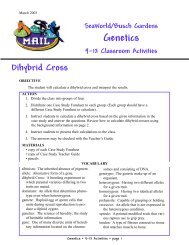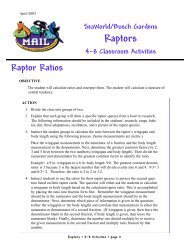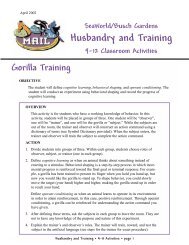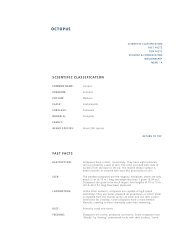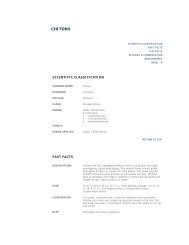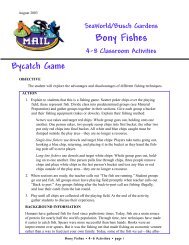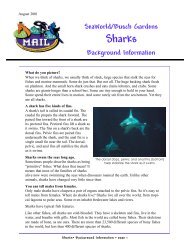Bioluminescence Funsheet - Sea World
Bioluminescence Funsheet - Sea World
Bioluminescence Funsheet - Sea World
You also want an ePaper? Increase the reach of your titles
YUMPU automatically turns print PDFs into web optimized ePapers that Google loves.
January/February 2004<br />
How Do You Glow That?<br />
OBJECTIVE<br />
ACTION<br />
<strong>Sea</strong><strong>World</strong>/Busch Gardens<br />
Invertebrates<br />
9-12 Classroom Activities<br />
The student will define and identify the chemical reaction of bioluminescence. The student will<br />
identify terrestrial and marine invertebrates that have luminescent capabilities.<br />
1. Divide the class into groups of four and distribute one <strong>Bioluminescence</strong> <strong>Funsheet</strong> to<br />
each group.<br />
2. Explain that each group will be conducting a bioluminescence scavenger hunt.<br />
<strong>Bioluminescence</strong> is an amazing capability that most marine invertebrates possess as<br />
well as a few terrestrial invertebrates. Each task on the scavenger hunt is worth a<br />
certain amount of points. Extra points may be awarded if the team provides more<br />
examples than asked for on the sheet. The teams will have one week to research and<br />
find all items on the scavenger hunt.<br />
3. Allow time for student groups to research items on the scavenger hunt (library, internet,<br />
or other resources).<br />
4. Instruct each team to present their scavenger hunt items and research to the class at<br />
the end of the week. The team with the most points gathered from their scavenger<br />
hunts wins. It is up to the teacher’s discretion to determine the prize (extra points on<br />
a homework assignment, quiz, etc.)<br />
MATERIALS<br />
• copy of <strong>Bioluminescence</strong> <strong>Funsheet</strong><br />
• pencils)<br />
• access to Internet, library, or other information resources<br />
Invertebrates • 9-12 Activities • page 15
<strong>Bioluminescence</strong> <strong>Funsheet</strong><br />
Use the Internet, library, or other information resources to answer the following questions<br />
about bioluminescence. Each question is worth 5 points and half points will be awarded<br />
for additional answers. Use another sheet of paper if necessary. Cite your sources.<br />
1. Define <strong>Bioluminescence</strong>.<br />
2. Identify the bioluminescence chemical reaction.<br />
3. Identify three or more terrestrial invertebrates that are bioluminescent.<br />
4. Identify five or more aquatic invertebrates that are bioluminescent.<br />
5. Identify three or more benefits for an invertebrate to have bioluminescent properties.<br />
6. Identify two or more uses that humans have developed for bioluminescent invertebrates.<br />
7. Why is most bioluminescence blue in color?<br />
8. Where can the most animals be found with bioluminescent capabilities?<br />
9. Some organisms can emit light continuously, but most emit flashes with varying durations<br />
from about _____ to _____ seconds.<br />
10. Identify the factor that determines how bright the bioluminescence is from<br />
photosynthetic dinoflagellates.<br />
Invertebrates • 9-12 Activities • page 16 © 2004 Busch Gardens
<strong>Bioluminescence</strong> <strong>Funsheet</strong><br />
Answers<br />
1. Define <strong>Bioluminescence</strong>.<br />
<strong>Bioluminescence</strong> is the ability of living organisms to produce light through a chemical<br />
reaction (living light).<br />
2. Identify the bioluminescence chemical reaction.<br />
Luciferin (protein) + Luciferas (enzyme) (in presence of O 2 + H 2 O + ATP) Light<br />
occurs at about 25ºC<br />
3. Identify three or more terrestrial invertebrates that are bioluminescent.<br />
Some earthworms, centipedes, fungi, and fireflies.<br />
4. Identify five or more aquatic invertebrates that are bioluminescent.<br />
Dinoflagellates, sea pansies, shrimp, squid, jellyfish,<br />
5. Identify three or more benefits for an invertebrate to have bioluminescent properties.<br />
Serves as a cloaking device, allowing prey to hide from predators. Some animals<br />
locate and lure prey with light, attract mates, and confuse predators.<br />
6. Identify two or more uses that humans have developed for bioluminescent<br />
invertebrates.<br />
Scientists have learned to use these lights as alternatives to radioactive labels.<br />
Scientists have used the chemical light from jellyfish to see inside cells. Scientists<br />
have studied bioluminescent patterns of how water flows over the surfaces of dolphins<br />
as they swim. This allows them to better understand dolphin adaptations for their<br />
marine environment and offers information useful to the better design of boats, submarines,<br />
and other marine vehicles.<br />
7. Why is most bioluminescence blue in color?<br />
Blue-green light travels the farthest in water. Its wavelength is between 440-479 nm,<br />
which is mid-range in the spectrum of colors. Additionally, most organisms are sensitive<br />
to only blue light. Many marine invertebrates do not have the visual pigments to<br />
absorb the longer or shorter wavelengths.<br />
8. Where can the most animals be found with bioluminescent capabilities?<br />
The ocean. Most animals living between 200 and 2,00 m deep (656 to 6,561 ft.) have<br />
some way of producing light.<br />
9. Some organisms can emit light continuously, but most emit flashes with varying<br />
durations from about _____ to _____ seconds.<br />
0.1 seconds to 10 seconds. Note: This time interval is an approximations and<br />
students’ answers may vary slightly.<br />
10. Identify the factor that determines how bright the bioluminescence is from photosynthetic<br />
dinoflagellates.<br />
The bioluminescence of photosynthetic dinoflagellates is greatly affected by the intensity<br />
of the previous day's sunlight. It is a positive correlation. The brighter the sunlight<br />
the previous day, the brighter the luminescence and vice versa.<br />
Invertebrates • 9-12 Activities • page 17 © 2004 Busch Gardens






